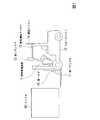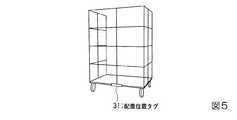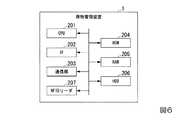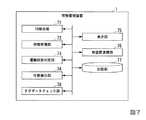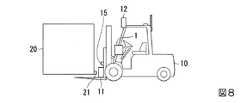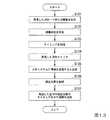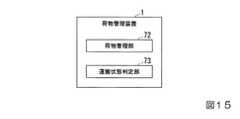JP6780269B2 - Luggage management device, luggage management method, program - Google Patents
Luggage management device, luggage management method, programDownload PDFInfo
- Publication number
- JP6780269B2 JP6780269B2JP2016054714AJP2016054714AJP6780269B2JP 6780269 B2JP6780269 B2JP 6780269B2JP 2016054714 AJP2016054714 AJP 2016054714AJP 2016054714 AJP2016054714 AJP 2016054714AJP 6780269 B2JP6780269 B2JP 6780269B2
- Authority
- JP
- Japan
- Prior art keywords
- antenna
- luggage
- forklift
- baggage
- detected
- Prior art date
- Legal status (The legal status is an assumption and is not a legal conclusion. Google has not performed a legal analysis and makes no representation as to the accuracy of the status listed.)
- Active
Links
- 238000007726management methodMethods0.000titleclaimsdescription129
- 230000007246mechanismEffects0.000claimsdescription10
- 230000006870functionEffects0.000claimsdescription6
- 238000010586diagramMethods0.000description21
- 238000001514detection methodMethods0.000description15
- 238000004891communicationMethods0.000description9
- 238000012545processingMethods0.000description9
- 238000000034methodMethods0.000description8
- 230000008676importEffects0.000description3
- 230000008569processEffects0.000description3
- 230000006866deteriorationEffects0.000description2
- 125000002066L-histidyl groupChemical group[H]N1C([H])=NC(C([H])([H])[C@](C(=O)[*])([H])N([H])[H])=C1[H]0.000description1
- 230000008859changeEffects0.000description1
- 238000006243chemical reactionMethods0.000description1
- 238000004590computer programMethods0.000description1
- 238000002474experimental methodMethods0.000description1
- 239000004065semiconductorSubstances0.000description1
- 238000012546transferMethods0.000description1
Images
Classifications
- B—PERFORMING OPERATIONS; TRANSPORTING
- B65—CONVEYING; PACKING; STORING; HANDLING THIN OR FILAMENTARY MATERIAL
- B65G—TRANSPORT OR STORAGE DEVICES, e.g. CONVEYORS FOR LOADING OR TIPPING, SHOP CONVEYOR SYSTEMS OR PNEUMATIC TUBE CONVEYORS
- B65G1/00—Storing articles, individually or in orderly arrangement, in warehouses or magazines
- B65G1/02—Storage devices
- B65G1/04—Storage devices mechanical
- B65G1/137—Storage devices mechanical with arrangements or automatic control means for selecting which articles are to be removed
- B—PERFORMING OPERATIONS; TRANSPORTING
- B66—HOISTING; LIFTING; HAULING
- B66F—HOISTING, LIFTING, HAULING OR PUSHING, NOT OTHERWISE PROVIDED FOR, e.g. DEVICES WHICH APPLY A LIFTING OR PUSHING FORCE DIRECTLY TO THE SURFACE OF A LOAD
- B66F9/00—Devices for lifting or lowering bulky or heavy goods for loading or unloading purposes
- B66F9/06—Devices for lifting or lowering bulky or heavy goods for loading or unloading purposes movable, with their loads, on wheels or the like, e.g. fork-lift trucks
- B66F9/075—Constructional features or details
- B66F9/20—Means for actuating or controlling masts, platforms, or forks
- B66F9/24—Electrical devices or systems
- B—PERFORMING OPERATIONS; TRANSPORTING
- B65—CONVEYING; PACKING; STORING; HANDLING THIN OR FILAMENTARY MATERIAL
- B65G—TRANSPORT OR STORAGE DEVICES, e.g. CONVEYORS FOR LOADING OR TIPPING, SHOP CONVEYOR SYSTEMS OR PNEUMATIC TUBE CONVEYORS
- B65G67/00—Loading or unloading vehicles
- B65G67/02—Loading or unloading land vehicles
- B65G67/04—Loading land vehicles
- B—PERFORMING OPERATIONS; TRANSPORTING
- B66—HOISTING; LIFTING; HAULING
- B66F—HOISTING, LIFTING, HAULING OR PUSHING, NOT OTHERWISE PROVIDED FOR, e.g. DEVICES WHICH APPLY A LIFTING OR PUSHING FORCE DIRECTLY TO THE SURFACE OF A LOAD
- B66F9/00—Devices for lifting or lowering bulky or heavy goods for loading or unloading purposes
- B66F9/06—Devices for lifting or lowering bulky or heavy goods for loading or unloading purposes movable, with their loads, on wheels or the like, e.g. fork-lift trucks
- B66F9/075—Constructional features or details
- B66F9/0755—Position control; Position detectors
Landscapes
- Engineering & Computer Science (AREA)
- Mechanical Engineering (AREA)
- Transportation (AREA)
- Structural Engineering (AREA)
- Civil Engineering (AREA)
- Life Sciences & Earth Sciences (AREA)
- Geology (AREA)
- Chemical & Material Sciences (AREA)
- Combustion & Propulsion (AREA)
- Aviation & Aerospace Engineering (AREA)
- Forklifts And Lifting Vehicles (AREA)
Description
Translated fromJapanese本発明は、荷物管理装置、荷物管理方法、プログラムに関する。 The present invention relates to a luggage management device, a luggage management method, and a program.
物流業界において荷物にRFIDタグを取り付けて、RFIDタグから荷物の識別番号を読み取ることにより荷物の物流管理を行っている。RFIDタグを用いて荷物の管理を行う技術が特許文献1および非特許文献1に開示されている。 In the logistics industry, RFID tags are attached to packages, and the distribution of packages is managed by reading the identification number of the packages from the RFID tags.
上述の特許文献1の技術ではフォークリフトがコンテナにフォーク形の腕を差し入れる際に、コンテナに添付されたRFIDタグのID情報を読み取る技術が開示されている。また非特許文献1にも同様の技術が記載されている。
しかしながら荷物自体にRFIDタグが付与されていない場合に適切な管理を行うことができなかった。The above-mentioned technique of
However, when the RFID tag is not attached to the luggage itself, proper management cannot be performed.
そこでこの発明は、上述の課題を解決する荷物管理装置、荷物管理方法、プログラムを提供することを目的としている。 Therefore, an object of the present invention is to provide a baggage management device, a baggage management method, and a program that solve the above-mentioned problems.
本発明の第1の態様によれば、荷物管理装置は、運搬車の荷物把持機構に設けられた第一アンテナから発信された無線信号の反射波を受信できる前記運搬車の所定の位置に設けられた第一発信装置であって前記無線信号の受信に基づいて前記第一発信装置の発信した第一IDを、前記第一アンテナで検出したか否かを判定する荷物管理部と、前記第一IDを検出した場合に荷物ID発信装置が取り付けられていない荷物を運搬していると判定する運搬状態判定部と、を備える。 According to the first aspect of the present invention, the luggage management device is provided at a predetermined position of the carrier capable of receiving the reflected wave of the radio signal transmitted from the first antenna provided in the luggage gripping mechanism of the carrier. A baggage management unit that determines whether or not the first ID transmitted by the first transmitter based on the reception of the radio signal is detected by the first antenna, and the first transmitter. It is provided with a transportation state determination unit that determines that a package to which a package ID transmitting device is not attached is being transported when one ID is detected.
本発明の第2の態様によれば、荷物管理方法は、運搬車の荷物把持機構に設けられた第一アンテナから発信された無線信号の反射波を受信できる前記運搬車の所定の位置に設けられた第一発信装置であって前記無線信号の受信に基づいて前記第一発信装置の発信した第一IDを、前記第一アンテナで検出したか否かを判定し、前記第一IDを検出した場合に荷物ID発信装置が取り付けられていない荷物を運搬していると判定する。 According to the second aspect of the present invention, the luggage management method is provided at a predetermined position of the carrier capable of receiving the reflected wave of the radio signal transmitted from the first antenna provided in the luggage gripping mechanism of the carrier. It is determined whether or not the first ID transmitted by the first transmitting device is detected by the first antenna based on the reception of the radio signal, and the first ID is detected. If this is the case, it is determined that the luggage ID transmitting device is not attached to carry the luggage.
本発明の第3の態様によれば、プログラムは、荷物管理装置のコンピュータを、運搬車の荷物把持機構に設けられた第一アンテナから発信された無線信号の反射波を受信できる前記運搬車の所定の位置に設けられた第一発信装置であって前記無線信号の受信に基づいて前記第一発信装置の発信した第一IDを、前記第一アンテナで検出したか否かを判定する荷物管理手段、前記第一IDを検出した場合に荷物ID発信装置が取り付けられていない荷物を運搬していると判定する運搬状態判定手段、として機能させる。 According to a third aspect of the present invention, the program allows the computer of the baggage management device to receive the reflected wave of the radio signal transmitted from the first antenna provided in the baggage gripping mechanism of the carrier. Luggage management that determines whether or not the first ID transmitted by the first transmitting device, which is the first transmitting device provided at a predetermined position and is transmitted by the first transmitting device based on the reception of the radio signal, is detected by the first antenna. The means, when the first ID is detected, functions as a transportation state determining means for determining that a luggage to which the luggage ID transmitting device is not attached is being transported.
本発明によれば、運搬車の荷物把持機構の油圧情報を得なくとも、運搬車が運搬する荷物を管理することができる。 According to the present invention, it is possible to manage the load carried by the carrier without obtaining the hydraulic pressure information of the load gripping mechanism of the carrier.
<第一実施形態>
以下、本発明の第一実施形態による荷物管理装置を図面を参照して説明する。
図1は同実施形態によるフォークリフトとコンテナとの関係を示す図である。
図1においてフォークリフト10は運搬車の一例である。またコンテナ20は荷物の一例である。フォークリフト10には、荷物管理装置1、第一アンテナ11、第二アンテナ12、衛星測位アンテナ13、通信アンテナ14、第一タグ15が備わる。<First Embodiment>
Hereinafter, the luggage management device according to the first embodiment of the present invention will be described with reference to the drawings.
FIG. 1 is a diagram showing a relationship between a forklift and a container according to the same embodiment.
In FIG. 1, the
第一アンテナ11はフォークリフトのフォーク(荷物把持機構)にとりつけられている。フォークリフト10の運転手はコンテナ20を運搬してそのコンテナ20を他の位置に移動させる際にはコンテナ20を所定の高さに持ち上げる。運転手はフォークリフト10を操作してコンテナ20を所定の高さに持ち上げることにより運転時の自身の視界を確保する。第二アンテナ12は、コンテナ20を運搬する際に運転手によってコンテナ20が持ち上げられた所定の高さにおいて第一アンテナ11の近傍に位置するようにフォークリフト10に予め設けられている。 The
第一タグ15は、第一アンテナ11から発信された無線信号のコンテナ20から反射した反射波を受信できるフォークリフト10の所定の位置に設けられている。コンテナ20にRFIDタグが取り付けられていない状態にはコンテナ20を管理することができない。したがって、フォークリフト10でRFIDタグが取り付けられていないコンテナ20を運ぶ場合には、第一アンテナ11の発信した無線信号がコンテナ20で反射し、この反射した無線信号を第一タグが受信する。第一タグはその反射した無線信号の受信に基づいて第一フォークリフトID(第一ID)を発信する。第一フォークリフトIDの無線信号はコンテナ20で反射して第一アンテナ11で受信する。RFIDタグが取り付けられていないコンテナ20を運んでいることを第一アンテナ11における第一フォークリフトIDの受信によって判定することができる。コンテナ20にRFIDタグが取り付けられている場合には、少なくとも第一アンテナ11はコンテナ20に取り付けられた荷物タグから発信された荷物IDと、第一タグ15から発信された第一フォークリフトIDの両方を受信することができる。
なお第一アンテナ11の発信する無線信号の指向性によって、第一タグ15では通常はその無線信号を検知できない位置に設けられている。フォーク上にコンテナ20などの反射部材が存在することによって当該無線信号が反射し、その反射した無線信号の受信によって第一タグ15は第一フォークリフトIDを発信することができるRFIDタグである。The
Due to the directivity of the radio signal transmitted by the
衛星測位アンテナ13は人工衛星からの信号を受信するアンテナである。人工衛星からの信号を受信してその信号に含まれる情報を荷物管理装置1が取得する。荷物管理装置1はその信号に含まれる情報に基づいてフォークリフトの位置を検出する。
通信アンテナ14は荷物管理装置1が他装置と通信する際に信号を送受信するアンテナである。通信アンテナ14は荷物管理装置1にケーブルにて接続されている。
荷物管理装置1は、コンテナ20などの荷物の搬入元や搬出先を判定する。また荷物管理装置1は荷物タグの取り付けられていないコンテナ20を運んでいることを検出する。以下、荷物管理装置1の詳細について説明する。The satellite positioning antenna 13 is an antenna that receives a signal from an artificial satellite. Upon receiving the signal from the artificial satellite, the
The communication antenna 14 is an antenna for transmitting and receiving signals when the
The
図2は搬入元または搬出先の例を示す第一の図である。
図2で示す搬入元または搬出先の例は第一のトラックを示している。第一のトラックには配置位置ID発信装置である配置位置タグ31が取り付けられている。FIG. 2 is a first diagram showing an example of a carry-in source or a carry-out destination.
The example of the import source or the export destination shown in FIG. 2 shows the first truck. An
図3は搬入元または搬出先の例を示す第二の図である。
図3で示す搬入元または搬出先の例は第二トラックを示している。第二のトラックにも配置位置タグ31が取り付けられている。FIG. 3 is a second diagram showing an example of a carry-in source or a carry-out destination.
The example of the carry-in source or the carry-out destination shown in FIG. 3 shows the second truck. The
図4は搬入元または搬出先の例を示す第三の図である。
図4で示す搬入元または搬出先の例は貨車を示している。貨車にも配置位置タグ31が取り付けられている。FIG. 4 is a third diagram showing an example of a carry-in source or a carry-out destination.
The example of the carry-in source or the carry-out destination shown in FIG. 4 shows a freight car. The
図5は搬入元または搬出先の例を示す第四の図である。
図5で示す搬入元または搬出先の例は、かご台車を示している。かご台車にも配置位置タグ31が取り付けられている。FIG. 5 is a fourth diagram showing an example of a carry-in source or a carry-out destination.
The example of the carry-in source or the carry-out destination shown in FIG. 5 shows a car trolley. The
本実施形態による荷物管理装置1は、コンテナヤードなどの敷地や、図2〜図5で示したトラック、貨車、かご台車などの搬入元や搬出先を特定する。トラック、貨車、かご台車などはコンテナ20を積載する積載用構造物の一例である。 The
図6は荷物管理装置のハードウェア構成を示す図である。
荷物管理装置1は、図6で示すように、CPU(Central Processing Unit)201、IF(Interface)202、通信モジュール203、ROM(Read Only Memory)204、RAM(Random Access Memory)205、HDD(Hard Disk Drive)206、RFIDリーダ207などの構成を備えている。通信モジュール203は通信アンテナ14を介した信号の送受信を行う。RFIDリーダ207は、第一アンテナ11や第二アンテナ12によって受信した信号の受信の制御を行う。IF202は、例えば荷物管理装置1に設けられたタッチパネルディスプレイ等に接続されている。FIG. 6 is a diagram showing a hardware configuration of the luggage management device.
As shown in FIG. 6, the
図7は荷物管理装置の機能ブロック図である。
荷物管理装置1は、予め記憶するプログラムをCPU101が実行することによりID検出部71、荷物管理部72、運搬状態判定部73、位置検出部74、表示部75、他装置連携部76タグデータチェック部78の機能を備える。また荷物管理装置1は記憶部77を備える。FIG. 7 is a functional block diagram of the luggage management device.
The
ID検出部71は、荷物タグ21、配置位置タグ31、第一タグ15から発信された信号に基づいてIDを検出する。当該IDは荷物ID、配置位置ID、第一フォークリフトIDなどである。荷物IDには荷物の識別情報が少なくとも含まれる。配置位置IDには配置位置が特定できるトラック、貨車、かご台車などの識別情報が少なくとも含まれる。第一フォークリフトIDにはフォークリフトを識別する第一の識別情報が含まれる。
荷物管理部72は、ID検出部71によるIDの検出状況に応じて荷物であるコンテナ20の搬入元や搬出先を判定する。The
The
運搬状態判定部73は、荷物IDを第一アンテナ11や第二アンテナ12で検出した状況に応じてフォークリフト10の荷物運搬状態を判定する。また運搬状態判定部73はRFIDタグの取り付けられていないコンテナ20を運搬していることを判定する。
位置検出部74は衛星測位アンテナ13を介して衛星から発信された信号に基づいてフォークリフト10の位置を検出する。
表示部75は荷物管理装置1に情報を表示する。
他装置連携部76は、通信アンテナ14を介して接続した他装置の間で情報を送受信する。
タグデータチェック部78は、受信した荷物ID、配置位置ID、第一フォークリフトIDなどに含まれるデータ体系をチェックする。
記憶部77は各種情報を記憶する。The transport
The
The
The other
The tag data check
The
図8はフォークリフトの第一の動作例を示す図である。
図8ではフォークリフト10の運転手が、コンテナヤードなどの敷地に置かれているコンテナ20の底にフォークリフト10のフォークを差し込んでいる状態を示す。この例はフォークリフト10が地面からコンテナ20を持ち上げて運び始める第一タイミング、またはフォークリフト10がコンテナ20を移動させて敷地の所定位置に配置する第二タイミングでみられる状況である。
荷物管理部72は第一タイミングと判定する場合は、まず、コンテナ20を運んでいない状態においては第一アンテナ11および第二アンテナ12で荷物IDを受信していないと判定する(1−a)。次にコンテナ20の下にフォークが差し込まれた際に、コンテナ20に荷物タグ21が取り付けられていれば荷物管理部72は第一アンテナ11のみで荷物IDと第一フォークリフトIDとを受信したと判定する(1−b1)。コンテナ20に荷物タグ21が取り付けられていない場合には、荷物管理部72は第一アンテナ11のみで第一フォークリフトIDを受信したと判定する(1−b2)。このような時系列の状況が生じた場合、荷物管理部72は第一タイミングが発生したと判定する。なお第二アンテナ12は、1−bの状況においては荷物IDや第一フォークリフトIDを検出できないような電波の指向性となるようフォークリフト10に取り付けられている。FIG. 8 is a diagram showing a first operation example of the forklift.
FIG. 8 shows a state in which the driver of the
When determining the first timing, the
荷物管理部72は第二タイミングと判定する場合では、運転手がフォークリフト10を操作してコンテナ20を持ち上げた場合、コンテナ20に荷物タグ21が取り付けられていれば第一アンテナ11と第二アンテナ12の両方で荷物IDと第一フォークリフトIDを受信していると判定する(2−a1)。また運転手がフォークリフト10を操作してコンテナ20を持ち上げた場合、コンテナ20に荷物タグ21が取り付けられていなければ第一アンテナ11と第二アンテナ12の両方で第一フォークリフトIDを受信していると判定する(2−a2)。次に荷物管理部72は、コンテナ20を移動先で置く際には、コンテナ20に荷物タグ21が取り付けられていれば第一アンテナ11のみで荷物IDと第一フォークリフトIDを受信していると判定する(2−b1)。また荷物管理部72は、コンテナ20を移動先で置く際には、コンテナ20に荷物タグ21が取り付けられていなければ第一アンテナ11のみで第一フォークリフトIDを受信していると判定する(2−b2)。そして荷物管理部72は、フォークリフト10がバックした場合には、第一アンテナ11と第二アンテナ12の両方で荷物IDまたは第一フォークリフトIDを受信していないと判定する(2−c)。このような時系列の状況が生じた場合、荷物管理部72は第二タイミングが発生したと判定する。なお第二アンテナ12は、2−b1または2−b2の状況においては荷物IDを検出できないような電波の指向性となるようフォークリフト10に取り付けられている。 When the
図9はフォークリフトの第二の動作例を示す図である。
図9ではフォークリフト10の運転手が、コンテナ20を積載する貨車にコンテナ20が配置されている状態においてコンテナ20の底にフォークリフト10のフォークを差し込んでいる状態を示す。この例はフォークリフト10が貨車からコンテナ20を持ち上げて他の位置へ運び始める第三タイミング、またはフォークリフト10がコンテナ20を他の位置から貨車に移動させて貨車に積載しようとする第四タイミングでみられる状況である。
荷物管理部72は第三タイミングと判定する場合は、まず第一アンテナ11と第二アンテナ12の両方で荷物IDや第一フォークリフトIDを検出できないと判定する(3−a)。次に荷物管理部72は、コンテナ20に荷物タグ21が取り付けられている場合には、第一アンテナ11で荷物IDと配置位置IDと第一フォークリフトIDを検出したと判定する(3−b1)。または荷物管理部72は、コンテナ20に荷物タグ21が取り付けられていない場合には、第一アンテナ11で配置位置IDと第一フォークリフトIDを検出したと判定する(3−b2)。このような時系列の状況が生じた場合、荷物管理部72は第三タイミングが発生したと判定する。なお第二アンテナ12は、3−b1や3−b2の状況においては荷物IDや配置位置IDや第一フォークリフトIDを検出できないような電波の指向性となるようフォークリフト10に取り付けられている。FIG. 9 is a diagram showing a second operation example of the forklift.
FIG. 9 shows a state in which the driver of the
When determining the third timing, the
荷物管理部72は第四タイミングと判定する場合は、コンテナ20に荷物タグ21が取り付けられていれば、フォークリフト10の走行中などには第一アンテナ11と第二アンテナ12の両方で荷物IDと第一フォークリフトIDを検出したと判定する(4−a1)。または荷物管理部72は第四タイミングと判定する場合は、コンテナ20に荷物タグ21が取り付けられていなければ、フォークリフト10の走行中などには第一アンテナ11と第二アンテナ12の両方で第一フォークリフトIDを検出したと判定する(4−a2)。次にコンテナを貨車に配置した際には、コンテナ20に荷物タグ21が取り付けられていれば、荷物管理部72は第二アンテナ12で荷物IDと第一フォークリフトIDの検出ができないと判定する(4−b1)。またはコンテナを貨車に配置した際には、コンテナ20に荷物タグ21が取り付けられていなければ、荷物管理部72は第二アンテナ12で第一フォークリフトIDの検出ができないと判定する(4−b2)。次に荷物管理部72はコンテナ20に荷物タグ21が取り付けられていれば、第一アンテナ11で荷物IDと配置位置IDと第一フォークリフトIDを検出したと判定する(4−c1)。または荷物管理部72はコンテナ20に荷物タグ21が取り付けられていなければ、第一アンテナ11で配置位置IDと第一フォークリフトIDを検出したと判定する(4−c2)。このような時系列の状況が生じた場合、荷物管理部72は第四タイミングが発生したと判定する。なお第二アンテナ12は、4−c1や4−c2の状況においては荷物ID、配置位置ID、第一フォークリフトIDなどを検出できないような電波の指向性となるようフォークリフト10に取り付けられている。 When the
図10はフォークリフトの第三の動作例を示す図である。
図10ではフォークリフト10の運転手が、コンテナ20が重ねて配置されている状態において上段に配置されているコンテナ20の底にフォークリフト10のフォークを差し込んでいる状態を示す。この例はフォークリフト10が上段に配置されているコンテナ20を持ち上げて他の位置へ運び始める第五タイミング、またはフォークリフト10がコンテナ20の上に他の位置から移動させたコンテナ20の配置を完了したとする第六タイミングでみられる状況である。FIG. 10 is a diagram showing a third operation example of the forklift.
FIG. 10 shows a state in which the driver of the
荷物管理部72は第五タイミングを判定する場合は、まずコンテナ20を運んでいないため、第一アンテナ11と第二アンテナ12の両方で荷物IDや第一フォークリフトIDが検出できていないと判定する(5−a)。次にフォークリフト10のフォークを上段のコンテナ20の底に差し込む為、コンテナ20に荷物タグ21が取り付けられている場合には荷物管理部72は第一アンテナ11と第二アンテナ12の両方で荷物IDと第一フォークリフトIDを検出したと判定する(5−b1)。またはフォークリフト10のフォークを上段のコンテナ20の底に差し込む為、コンテナ20に荷物タグ21が取り付けられていない場合には荷物管理部72は第一アンテナ11と第二アンテナ12の両方で第一フォークリフトIDを検出したと判定する(5−b2)。このような時系列の状況が生じた場合、荷物管理部72は第五タイミングが発生したと判定する。
荷物管理部72は第六タイミングを判定する場合は、コンテナ20に荷物タグ21が取り付けられていれば、フォークリフト10の走行中において第一アンテナ11と第二アンテナ12の両方で荷物IDと第一フォークリフトIDを検出したと判定する(6−a1)。コンテナ20に荷物タグ21が取り付けられていなければ、フォークリフト10の走行中において第一アンテナ11と第二アンテナ12の両方で第一フォークリフトIDを検出したと判定する(6−a2)。また荷物管理部72は第一アンテナ11と第二アンテナ12の両方で荷物IDや第一フォークリフトIDを検出している時間が所定時間以上であると判定する(6−b)。また荷物管理部72は第一アンテナ11と第二アンテナ12の両方で荷物IDや第一フォークリフトIDを検出できなくなったと判定する。このような時系列の状況が生じた場合、荷物管理部72は第六タイミングが発生したと判定する。When determining the fifth timing, the
When the
なお上述の図8〜図10で示した各タイミングの判定手法は一例であって、第一アンテナ11や第二アンテナ12で受信した荷物IDや配置位置IDや第一フォークリフトIDの受信時刻や時系列での受信状況に応じて上記各タイミングやその他のタイミングを判定するようにして良い。 The timing determination method shown in FIGS. 8 to 10 described above is an example, and is the reception time and time of the luggage ID, the arrangement position ID, and the first forklift ID received by the
図11はフォークリフトの一連の動作を示す第一の図である。
次にフォークリフトがコンテナヤードなどの敷地に置かれているコンテナ20を敷地内の他の位置に配置する場合の例について説明する。この場合コンテナヤードの敷地のコンテナ20が置かれている位置が搬入元である。また他の位置が搬出先である。またコンテナ20には荷物タグが取り付けられていない場合の例を用いて説明する。
運転手はフォークリフト10を操作してコンテナ20の底にフォークリフト10のフォークを差し込む(ステップS1)。これにより第一アンテナ11で発信した無線信号がコンテナ20で反射する。第一タグ15は、第一アンテナ11から発信された無線信号の反射信号の受信に基づいて第一フォークリフトIDを発信する。第一アンテナ11は第一フォークリフトIDを受信する。荷物管理部72は、第一アンテナ11において第一フォークリフトIDを検出したと判定し、第一タイミングであることを検出する。荷物管理部72は第一フォークリフトIDを取得した時点におけるフォークリフト10の現在位置を位置検出部74から取得する。荷物管理部72は荷物タグ21が取り付けられていないことを示す情報と、現在位置とを記憶部77に一次記録する。また荷物管理部72は荷物タグ21が取り付けられていないことを示す情報と、現在位置とを他装置連携部76に出力する。他装置連携部76は荷物タグ21が取り付けられていないことを示す情報と現在位置と第一フォークリフトIDとを上位システムに通知してよい。この通知には第一タイミングであることを示す情報を含ませるようにしてよい。このような処理により上位システムは、どのフォークリフトが、何時、どの位置で、どの荷物に対して、何をしているかを管理することができる。また上位システムでは荷物タグ21の取り付けられていないコンテナ20がどこに存在するかを検出することができる。FIG. 11 is a first diagram showing a series of operations of the forklift.
Next, an example will be described in which the
The driver operates the
運転手はコンテナ20を敷地内の他の位置に移動させる。この際運転手はフォークリフト10のフォークを持ち上げて視界を確保する(ステップS2)。そうすると第一アンテナ11と第二アンテナ12でそれぞれ第一フォークリフトIDを受信する。第一タイミングからこの状態に移行すると、運搬状態判定部73は運搬中であることを判定する。運転手は敷地内の所定の搬出先の配置位置に到着すると、その位置にコンテナ20を配置する。この時第二アンテナ12における第一フォークリフトIDの検出ができなくなる。荷物管理部72は第二タイミングであることを検出する。荷物管理部72は、第二タイミングであると検出した時の現在位置を位置検出部74から取得する。フォークリフト10がバックすると荷物管理部72は第一アンテナ11で第一フォークリフトIDの検出ができなくなったと判定する(ステップS3)。荷物管理部72は第一アンテナ11および第二アンテナ12で検出しなくなった第一フォークリフトIDと、現在位置を他装置連携部76に出力する。他装置連携部76は第一フォークリフトIDと現在位置を、第二タイミングを検知したことを上位システムに通知してよい。このような処理により上位システムは、どのフォークリフトが、何時、どの位置で、どの荷物に対して、何をしているかを管理することができる。また上位システムでは荷物タグ21の取り付けられていないコンテナ20がどこに存在するかを検出することができる。 The driver moves the
図12はフォークリフトの一連の動作を示す第二の図である。
次にフォークリフト10が一方の貨車41に置かれているコンテナ20を、他方の貨車42に配置する場合の例について説明する。この場合、一方の貨車41が搬入元である。また他方の貨車42が搬出先である。なおコンテナ20には荷物タグが取り付けられていない場合の例を用いて説明する。
運転手はフォークリフト10を操作して貨車41に積載されているコンテナ20の底にフォークリフト10のフォークを差し込む(ステップS121)。これにより第一アンテナ11で発信した無線信号がコンテナ20で反射する。第一タグ15は、第一アンテナ11から発信された無線信号の反射信号の受信に基づいて第一フォークリフトIDを発信する。第一アンテナ11は第一フォークリフトIDを受信する。また第一アンテナ11は配置位置タグ31から発信された配置位置IDを受信する。荷物管理部72は、第一アンテナ11において第一フォークリフトIDと配置位置IDを検出したと判定し、第三タイミングであることを検出する(図9)。なおタグデータチェック部78は配置位置IDが貨車を示すかどうかを判定してもよい。例えば予め貨車からの荷物を搬出する場合に、タグデータチェック部78は配置位置IDが貨車かどうかを判定し、貨車でない場合には警告表示を行うと判定してもよい。貨車41にコンテナ20が複数連なって配置されていた場合には第一アンテナ11は他のコンテナ20に取り付けられている荷物タグ21から荷物IDを受信してしまう可能性が有る。荷物管理部72はコンテナ20の荷物IDを検出した場合、受信強度が第一フォークリフトIDと同じ程度に高い信号かを判定し、第一フォークリフトIDと同じ程度に高い信号でない場合には破棄してよい。またこの時、貨車に複数の配置位置タグ31が取り付けられている場合には、荷物管理部72は、複数の配置位置IDを受信したと判定する可能性がある。その場合荷物管理部72は、第一フォークリフトIDを受信した信号の強度と同程度の信号強度の信号により配置位置IDを受信したかを判定する。第一フォークリフトIDと同程度の信号強度の信号により配置位置IDを受信していれば、荷物タグ21の取り付けられていない荷物と配置位置とが一致している。したがって、荷物管理部72は、第一フォークリフトIDと同程度の信号強度により受信した配置位置IDを取得する。FIG. 12 is a second diagram showing a series of operations of the forklift.
Next, an example will be described in which the
The driver operates the
荷物管理部72は第一フォークリフトIDと配置位置IDとを取得した時点におけるフォークリフト10の現在位置を位置検出部74から取得する。荷物管理部72は第一フォークリフトID、配置位置ID、現在位置を記憶部77に一次記録する。また荷物管理部72は第一フォークリフトID、配置位置ID、現在位置を他装置連携部76に出力する。他装置連携部76は第一フォークリフトID、配置位置ID、現在位置を上位システムに通知してよい。この通知には第三タイミングであることを示す情報を含ませるようにして良い。このような処理によりフォークリフトが何時、どの位置で、どの荷物に対して、何をしているかを上位システムで管理することができる。また上位システムでは荷物タグ21の取り付けられていないコンテナ20がどこに存在するかを検出することができる。 The
運転手はコンテナ20を他方の貨車42に移動させる。この際運転手はフォークリフト10のフォークを持ち上げて視界を確保する(ステップS122)。そうすると第一アンテナ11と第二アンテナ12でそれぞれ第一フォークリフトIDを受信する。第三タイミングからこの状態に移行すると、運搬状態判定部73は運搬中であることを判定する。運転手は他方の貨車42に到着すると、貨車42にコンテナ20を配置する。この時第二アンテナ12における第一フォークリフトIDの検出ができなくなる。また第一アンテナ11では第一フォークリフトIDと共に貨車42に取り付けられている配置位置タグ31の配置位置IDを受信する。これにより荷物管理部72は第四タイミングであることを検出する。なおこの時、貨車に複数の配置位置タグ31が取り付けられている場合には、荷物管理部72は、複数の配置位置IDを受信したと判定する可能性がある。その場合荷物管理部72は、第一フォークリフトIDを受信した信号の強度と同程度の信号強度の信号により配置位置IDを受信したかを判定する。第一フォークリフトIDと同程度の信号強度の信号により配置位置IDを受信していれば、荷物タグ21の取り付けられていないコンテナ20と配置位置とが一致している。したがって、荷物管理部72は、第一フォークリフトIDの信号強度と同程度の信号強度により受信した配置位置IDを取得する。 The driver moves the
荷物管理部72は、第四タイミングであると検出した時の現在位置を位置検出部74から取得する。フォークリフト10がバックすると荷物管理部72は第一アンテナ11で第一フォークリフトIDと配置位置IDの検出ができなくなる(ステップS123)。荷物管理部72はそれら第一フォークリフトIDと配置IDとを他装置連携部76に出力する。他装置連携部76は第一フォークリフトID、配置位置ID、現在位置、フォークリフトID、第四タイミングを検知したことを上位システムに通知してよい。このような処理により上位システムは、どのフォークリフトが、何時、どの位置で、どの荷物に対して、何をしているかを管理することができる。また上位システムでは荷物タグ21の取り付けられていないコンテナ20がどこに存在するかを検出することができる。 The
図13は荷物管理装置1の処理フローを示す図である。
荷物管理装置1において荷物管理部72は、第一アンテナ11において受信したIDが荷物ID、配置位置ID、第一フォークリフトID、第二フォークリフトIDの一つまたは複数のどれであるかを判定する(ステップS131)。次に運搬状態判定部73がフォークリフトの運搬状態を判定する(ステップS132)。荷物管理部72は運搬状態を検出し、また受信したIDを特定し、記録しているそれらの時系列の情報に基づいて現在のタイミング(上記第一〜第六のタイミングなど)を判定する(ステップS133)。またタグデータチェック部78は、受信した荷物IDまたは配置位置IDをチェックする(ステップS134)。タグデータチェック部78はそれらチェックした荷物IDや配置位置IDのデータ体系が記憶部77に記録されている体系に合致しない場合には、警告情報などをモニタに出力してよい。荷物管理部72は現在のタイミングが所定のタイミングである場合には、上位システムに情報を送信すると決定する(ステップS135)。荷物管理部72は位置検出部74から現在位置を取得する(ステップS136)。荷物管理部72は、上位システムに荷物ID、配置位置ID、第一フォークリフトID、第二フォークリフトIDや現在位置やタイミングを示す情報を送信する(ステップS137)。FIG. 13 is a diagram showing a processing flow of the
In the
荷物管理装置1は、上位システムなどから予め、作業予定リストを受信して記憶しておいてもよい。作業予定リストには、運搬するコンテナの荷物IDの順番や、搬入元、搬出先の情報が記録されている。荷物管理装置1の荷物管理部72は、運搬するコンテナの荷物IDの順番や、そのコンテナ20の搬入元と搬出先とを比較して、作業予定リストに一致するかを判定するようにしてもよい。この場合、荷物管理部72はフォークリフトの仕事状況の時系列による情報が、作業予定リストに一致しない場合には、警告情報をタッチパネルディスプレイなどに表示するようにしてもよい。これにより作業者の荷物の誤移送を削減することができる。 The
荷物管理装置1は記憶部に地図を記憶しておき、表示部75が地図と現在位置とをディスプレイに表示するようにしてもよい。
また荷物管理装置1は荷物タグ21、配置位置タグ31、第一タグ15、第二タグ16からの信号の強度を検出して、その信号強度を記憶しておき、信号強度の変換を管理してもよい。荷物管理装置1は信号強度が著しく弱くなったかを判定し、弱くなった場合には、荷物タグ21、配置位置タグ31、第一タグ15、第二タグ16の劣化を判断してもよい。この場合荷物管理装置1は、劣化した荷物タグ21、配置位置タグ31、第一タグ15、第二タグ16の情報(荷物ID、配置位置ID、第一フォークリフトID、第二フォークリフトID)や現在位置を含む劣化信号を上位システムへ出力する。これにより上位システムにおいて劣化した荷物タグ21や配置位置タグ31を特定することができる。The
Further, the
上述の第一アンテナ11や第二アンテナ12は指向性を制御できる機能を有していてもよい。例えば荷物管理装置1は、電気的、または機械的に第一アンテナ11や第二アンテナ12の指向性の向きや電波出力強度を変化させることができてよい。例えば第一アンテナ11に比較して、第二アンテナ12の指向性や出力を高め、遠い場所にある各タグからの信号を受信できるようにしてもよい。 The
<第二の実施形態>
次にフォークリフトが第二アンテナ12の代わりに第二タグ16を備える場合の例について説明する。
図14に示すようにフォークリフトに第二タグ16が取り付けられているとする。第二タグ16は、フォークリフト10のフォークが走行中などに所定の高さに持ち上げた場合に第一アンテナ11の近傍に位置するように予めフォークリフト10に取り付けられている。第二タグ16は、フォークが所定の位置に持ち上げられている際に第一アンテナ11から発信された無線信号がコンテナ20において反射した信号を受信する。これにより第二タグ16は第二フォークリフトIDを発信する。第二フォークリフトIDの信号はコンテナ20で反射して第一アンテナ11で受信する。<Second embodiment>
Next, an example in which the forklift is provided with the second tag 16 instead of the
It is assumed that the second tag 16 is attached to the forklift as shown in FIG. The second tag 16 is attached to the
図14は第二実施形態によるフォークリフトの一連の動作を示す第一の図である。
次にフォークリフトがコンテナヤードなどの敷地に置かれているコンテナ20を敷地内の他の位置に配置する場合の第二の実施形態における例について説明する。この場合コンテナヤードの敷地のコンテナ20が置かれている位置が搬入元である。また他の位置が搬出先である。コンテナ20には荷物タグが取り付けられていない場合の例を用いて説明する。
運転手はフォークリフト10を操作してコンテナ20の底にフォークリフト10のフォークを差し込む(ステップS141)。これにより第一アンテナ11で発信した無線信号がコンテナ20で反射する。第一タグ15は、第一アンテナ11から発信された無線信号の反射信号の受信に基づいて第一フォークリフトIDを発信する。第一アンテナ11は第一フォークリフトIDを受信する。荷物管理部72は、第一アンテナ11において第一フォークリフトIDを検出したと判定し、第一タイミングであることを検出する。荷物管理部72は第一フォークリフトIDを取得した時点におけるフォークリフト10の現在位置を位置検出部74から取得する。荷物管理部72は荷物タグ21が取り付けられていないことを示す情報と、現在位置とを記憶部77に一次記録する。また荷物管理部72は荷物タグ21が取り付けられていないことを示す情報と、現在位置とを他装置連携部76に出力する。他装置連携部76は荷物タグ21が取り付けられていないことを示す情報と現在位置と第一フォークリフトIDとを上位システムに通知してよい。この通知には第一タイミングであることを示す情報を含ませるようにしてよい。このような処理により上位システムは、どのフォークリフトが、何時、どの位置で、どの荷物に対して、何をしているかを管理することができる。また上位システムでは荷物タグ21の取り付けられていないコンテナ20がどこに存在するかを検出することができる。FIG. 14 is a first diagram showing a series of operations of the forklift according to the second embodiment.
Next, an example in the second embodiment in which the
The driver operates the
運転手はコンテナ20を敷地内の他の位置に移動させる。この際運転手はフォークリフト10のフォークを持ち上げて視界を確保する(ステップS142)。そうすると第一アンテナ11で第一フォークリフトIDと第二フォークリフトIDを受信する。第一タイミングからこの状態に移行すると、運搬状態判定部73は運搬中であることを判定する。運転手は敷地内の所定の搬出先の配置位置に到着すると、その位置にコンテナ20を配置する。この時第一アンテナ11における第一フォークリフトIDと第二フォークリフトIDの検出ができなくなる。これにより荷物管理部72は第二タイミングであることを検出する。荷物管理部72は、第二タイミングであると検出した時の現在位置を位置検出部74から取得する。フォークリフト10がバックすると荷物管理部72は第一アンテナ11で第一フォークリフトIDの検出ができなくなったと判定する(ステップS143)。荷物管理部72は第一アンテナ11で検出しなくなった第一フォークリフトIDまたは第二フォークリフトIDと、現在位置を他装置連携部76に出力する。他装置連携部76は第一フォークリフトIDまたは第二フォークリフトIDと現在位置を、第二タイミングを検知したことを上位システムに通知してよい。このような処理により上位システムは、どのフォークリフトが、何時、どの位置で、どの荷物に対して、何をしているかを管理することができる。また上位システムでは荷物タグ21の取り付けられていないコンテナ20がどこに存在するかを検出することができる。The driver moves the
図15は荷物管理装置の最小構成を示す図である。
図15で示すように荷物管理装置1は少なくとも荷物管理部72と運搬状態判定部73を備える。
荷物管理部72はフォークリフト10フォークに設けられた第一アンテナ11から発信された無線信号の反射波を受信できるフォークリフト10の所定の位置に設けられた第一タグ15であって無線信号の受信に基づいて第一タグ15の発信した第一IDを、第一アンテナ11で検出したか否かを判定する。
運搬状態判定部72は、第一IDを検出した場合に荷物IDタグ21が取り付けられていないコンテナ20を運搬していると判定する。FIG. 15 is a diagram showing the minimum configuration of the luggage management device.
As shown in FIG. 15, the
The
When the first ID is detected, the transport
上述の荷物管理装置は内部に、コンピュータシステムを有している。そして、上述した各処理の過程は、プログラムの形式でコンピュータ読み取り可能な記録媒体に記憶されており、このプログラムをコンピュータが読み出して実行することによって、上記処理が行われる。ここでコンピュータ読み取り可能な記録媒体とは、磁気ディスク、光磁気ディスク、CD−ROM、DVD−ROM、半導体メモリ等をいう。また、このコンピュータプログラムを通信回線によってコンピュータに配信し、この配信を受けたコンピュータが当該プログラムを実行するようにしても良い。 The above-mentioned luggage management device has a computer system inside. The process of each process described above is stored in a computer-readable recording medium in the form of a program, and the process is performed by the computer reading and executing this program. Here, the computer-readable recording medium refers to a magnetic disk, a magneto-optical disk, a CD-ROM, a DVD-ROM, a semiconductor memory, or the like. Further, this computer program may be distributed to a computer via a communication line, and the computer receiving the distribution may execute the program.
また、上記プログラムは、前述した機能の一部を実現するためのものであっても良い。さらに、前述した機能をコンピュータシステムにすでに記録されているプログラムとの組み合わせで実現できるもの、いわゆる差分ファイル(差分プログラム)であっても良い。 Further, the above program may be for realizing a part of the above-mentioned functions. Further, a so-called difference file (difference program) may be used, which can realize the above-mentioned functions in combination with a program already recorded in the computer system.
1・・・荷物管理装置
10・・・フォークリフト
11・・・第一アンテナ
12・・・第二アンテナ
13・・・衛星測位アンテナ
14・・・通信アンテナ
15・・・第一タグ
16・・・第二タグ
20・・・コンテナ
21・・・荷物タグ
71・・・ID検出部
72・・・荷物管理部
73・・・運搬状態判定部
74・・・位置検出部
75・・・表示部
76・・・他装置連携部
77・・・記憶部
78・・・タグデータチェック部1 ...
Claims (6)
Translated fromJapanese前記第一IDを検出した場合に荷物ID発信装置が取り付けられていない荷物を運搬していると判定する運搬状態判定部と、
を備える荷物管理装置。It is a first transmitter provided at a predetermined position of the carrier capable of receiving the reflected wave of the radio signal transmitted from the first antenna provided in the luggage gripping mechanism of the carrier, and is based on the reception of the radio signal. A baggage management unit that determines whether or not the first ID transmitted by the first transmitter is detected by the first antenna.
When the first ID is detected, a transport state determination unit that determines that a package to which a package ID transmitter is not attached is being transported, and a transport status determination unit.
Luggage management device equipped with.
請求項1に記載の荷物管理装置。The baggage management device according to claim 1, wherein the baggage management unit determines whether or not a baggage ID transmitted from the baggage ID transmitting device attached to the baggage is detected by the first antenna.
前記荷物把持機構を所定の高さに持ち上げた場合に前記第一アンテナの近傍に位置するように前記運搬車に予め設けられた第二アンテナで前記第一IDを検出したか否かを判定し、
前記第一IDを前記第一アンテナと前記第二アンテナのそれぞれで検出した状況に応じて前記荷物の搬入元における運搬に関するタイミング種別または搬出先における運搬に関するタイミング種別を判定し、前記タイミング種別の判定結果に基づいて、現在位置と前記第一IDとを上位システム送信する
請求項1または請求項2に記載の荷物管理装置。The luggage management department
It is determined whether or not the first ID is detected by the second antenna provided in advance on the transport vehicle so as to be located in the vicinity of the first antenna when the luggage gripping mechanism is lifted to a predetermined height. ,
Depending on the situation in which the first ID is detected by each of the first antenna and the second antenna, thetiming type related to the transportation at the loading source or thetiming type related tothe transportation at the unloading destination is determined,and the timing type is determined. The baggage management device accordingto claim 1 or 2,wherein the current position and the first ID are transmitted to the host system based on the result .
前記荷物把持機構を所定の高さに持ち上げた場合に前記第一アンテナの近傍に位置するように前記運搬車に予め設けられた第二発信装置であって第一アンテナから発信された無線信号の受信に基づいて前記第二発信装置の発信した第二IDを、前記第一アンテナで検出したか否かを判定し、
前記第一IDと前記第二IDとを前記第一アンテナで検出した状況に応じて前記荷物の搬入元における運搬に関するタイミング種別または搬出先における運搬に関するタイミング種別を判定し、前記タイミング種別の判定結果に基づいて、現在位置と前記第一IDとを上位システム送信する
請求項1または請求項2に記載の荷物管理装置。The luggage management department
A second transmitter provided in advance on the carrier so as to be located in the vicinity of the first antenna when the luggage gripping mechanism is lifted to a predetermined height, and is a radio signal transmitted from the first antenna. Based on the reception, it is determined whether or not the second ID transmitted by the second transmitting device is detected by the first antenna.
Depending on the situation in which the first ID and the second ID are detected by the first antenna, thetiming type related to transportation at the loading source or thetiming type related totransportation at the unloading destination is determined,and the determination result of the timing type is determined. The baggage management device accordingto claim 1 or 2,wherein the current position and the first ID are transmitted to the host system based on the above .
前記第一IDを検出した場合に荷物ID発信装置が取り付けられていない荷物を運搬していると判定する
荷物管理方法。It is a first transmitter provided at a predetermined position of the carrier capable of receiving the reflected wave of the radio signal transmitted from the first antenna provided in the luggage gripping mechanism of the carrier, and is based on the reception of the radio signal. It is determined whether or not the first ID transmitted by the first transmitting device is detected by the first antenna.
A baggage management method for determining that a baggage to which a baggage ID transmitting device is not attached is being carried when the first ID is detected.
運搬車の荷物把持機構に設けられた第一アンテナから発信された無線信号の反射波を受信できる前記運搬車の所定の位置に設けられた第一発信装置であって前記無線信号の受信に基づいて前記第一発信装置の発信した第一IDを、前記第一アンテナで検出したか否かを判定する荷物管理手段、
前記第一IDを検出した場合に荷物ID発信装置が取り付けられていない荷物を運搬していると判定する運搬状態判定手段、
として機能させるプログラム。The computer of the luggage management device,
It is a first transmitter provided at a predetermined position of the carrier capable of receiving the reflected wave of the radio signal transmitted from the first antenna provided in the luggage gripping mechanism of the carrier, and is based on the reception of the radio signal. A baggage management means for determining whether or not the first ID transmitted by the first transmitting device is detected by the first antenna.
A transportation state determining means for determining that a package to which a package ID transmitting device is not attached is being transported when the first ID is detected.
A program that functions as.
Priority Applications (6)
| Application Number | Priority Date | Filing Date | Title |
|---|---|---|---|
| JP2016054714AJP6780269B2 (en) | 2016-03-18 | 2016-03-18 | Luggage management device, luggage management method, program |
| MYPI2018703166AMY193880A (en) | 2016-03-18 | 2017-03-01 | Cargo management device, cargo management method, and program |
| SG11201807518WASG11201807518WA (en) | 2016-03-18 | 2017-03-01 | Cargo management device, cargo management method, and program |
| US16/083,544US10875710B2 (en) | 2016-03-18 | 2017-03-01 | Cargo management device, cargo management method, and program |
| PCT/JP2017/008095WO2017159364A1 (en) | 2016-03-18 | 2017-03-01 | Cargo management device, cargo management method, and program |
| PH12018501934APH12018501934A1 (en) | 2016-03-18 | 2018-09-10 | Cargo management device, cargo management method, and program |
Applications Claiming Priority (1)
| Application Number | Priority Date | Filing Date | Title |
|---|---|---|---|
| JP2016054714AJP6780269B2 (en) | 2016-03-18 | 2016-03-18 | Luggage management device, luggage management method, program |
Publications (2)
| Publication Number | Publication Date |
|---|---|
| JP2017165570A JP2017165570A (en) | 2017-09-21 |
| JP6780269B2true JP6780269B2 (en) | 2020-11-04 |
Family
ID=59852252
Family Applications (1)
| Application Number | Title | Priority Date | Filing Date |
|---|---|---|---|
| JP2016054714AActiveJP6780269B2 (en) | 2016-03-18 | 2016-03-18 | Luggage management device, luggage management method, program |
Country Status (6)
| Country | Link |
|---|---|
| US (1) | US10875710B2 (en) |
| JP (1) | JP6780269B2 (en) |
| MY (1) | MY193880A (en) |
| PH (1) | PH12018501934A1 (en) |
| SG (1) | SG11201807518WA (en) |
| WO (1) | WO2017159364A1 (en) |
Families Citing this family (2)
| Publication number | Priority date | Publication date | Assignee | Title |
|---|---|---|---|---|
| JP6418539B1 (en)* | 2018-01-30 | 2018-11-07 | パナソニックIpマネジメント株式会社 | Work management apparatus, work management method, and computer program |
| US11952250B2 (en)* | 2018-09-26 | 2024-04-09 | Bridgestone Europe Nv/Sa | Forklift for the handling of pneumatic tires provided with transponder |
Family Cites Families (13)
| Publication number | Priority date | Publication date | Assignee | Title |
|---|---|---|---|---|
| US6669089B2 (en)* | 2001-11-12 | 2003-12-30 | 3M Innovative Properties Co | Radio frequency identification systems for asset tracking |
| US7639142B2 (en)* | 2005-05-13 | 2009-12-29 | Ems Technologies, Inc. | Systems and methods for order-picking |
| JP4860978B2 (en)* | 2005-10-17 | 2012-01-25 | 富士通株式会社 | Container management system and program |
| US7725212B2 (en)* | 2005-10-21 | 2010-05-25 | Hewlett-Packard Development Company, L.P. | Datacenter with automated robotic maintenance |
| US7744331B2 (en)* | 2006-01-26 | 2010-06-29 | Xerox Corporation | Transport vehicle and method |
| JP4939081B2 (en)* | 2006-02-28 | 2012-05-23 | 住友金属工業株式会社 | Management method of article using ID tag |
| JP2008019046A (en) | 2006-07-12 | 2008-01-31 | Sankyu Inc | Transportation vehicle and container management system |
| CA2558626C (en)* | 2006-09-21 | 2008-05-20 | Tenxc Wireless Inc. | Highly-accurate radio location of beacons in a warehouse |
| US7612673B2 (en)* | 2007-05-30 | 2009-11-03 | Kimberly-Clark Worldwide, Inc. | RFID system for lifting devices |
| US9007178B2 (en)* | 2008-02-14 | 2015-04-14 | Intermec Ip Corp. | Utilization of motion and spatial identification in RFID systems |
| WO2012103002A2 (en)* | 2011-01-24 | 2012-08-02 | Sky-Trax, Inc. | Inferential load tracking |
| US8862313B2 (en)* | 2011-08-09 | 2014-10-14 | Continental Automotive Systems, Inc | Smart trailer RFID system |
| US9415513B2 (en)* | 2014-08-29 | 2016-08-16 | General Electric Company | Systems and methods for railyard robotics |
- 2016
- 2016-03-18JPJP2016054714Apatent/JP6780269B2/enactiveActive
- 2017
- 2017-03-01SGSG11201807518WApatent/SG11201807518WA/enunknown
- 2017-03-01USUS16/083,544patent/US10875710B2/enactiveActive
- 2017-03-01WOPCT/JP2017/008095patent/WO2017159364A1/enactiveApplication Filing
- 2017-03-01MYMYPI2018703166Apatent/MY193880A/enunknown
- 2018
- 2018-09-10PHPH12018501934Apatent/PH12018501934A1/enunknown
Also Published As
| Publication number | Publication date |
|---|---|
| US10875710B2 (en) | 2020-12-29 |
| US20190127145A1 (en) | 2019-05-02 |
| SG11201807518WA (en) | 2018-10-30 |
| MY193880A (en) | 2022-10-30 |
| JP2017165570A (en) | 2017-09-21 |
| PH12018501934A1 (en) | 2019-06-17 |
| WO2017159364A1 (en) | 2017-09-21 |
Similar Documents
| Publication | Publication Date | Title |
|---|---|---|
| US10815080B2 (en) | Automatic truck loading and unloading system | |
| US10673948B2 (en) | Trailer identification, inspection, and verification using a vehicle gateway | |
| CA2767244C (en) | System for shipping container handling equipment inventory | |
| CA2902295C (en) | Dynamic inventory tracking and transfer system | |
| EP1942453A2 (en) | Methods and systems for automating inventory and dispatch procedures at a staging area | |
| JP6780268B2 (en) | Luggage management device, luggage management method, program | |
| JP6780269B2 (en) | Luggage management device, luggage management method, program | |
| JP5094164B2 (en) | Container loading / unloading reception system | |
| JP6891436B2 (en) | Work management equipment, work management methods, programs, cargo handling machines | |
| US11403471B2 (en) | Delivery monitoring device, delivery management method, recording medium | |
| JP6763266B2 (en) | Management device, management method, program | |
| JP2010235223A (en) | System and method for data management | |
| JP7036172B2 (en) | Management equipment, management method, program | |
| JP6897044B2 (en) | Management device, management method, program | |
| JP2021051636A (en) | Container management device and container management system | |
| JP4496936B2 (en) | Transportation means and loading confirmation system | |
| JP2004250209A (en) | Warehouse management system | |
| JP2021088416A (en) | Freight car container loading position management system and transport object loading position management system |
Legal Events
| Date | Code | Title | Description |
|---|---|---|---|
| A621 | Written request for application examination | Free format text:JAPANESE INTERMEDIATE CODE: A621 Effective date:20190208 | |
| A131 | Notification of reasons for refusal | Free format text:JAPANESE INTERMEDIATE CODE: A131 Effective date:20200327 | |
| A521 | Request for written amendment filed | Free format text:JAPANESE INTERMEDIATE CODE: A523 Effective date:20200526 | |
| TRDD | Decision of grant or rejection written | ||
| A01 | Written decision to grant a patent or to grant a registration (utility model) | Free format text:JAPANESE INTERMEDIATE CODE: A01 Effective date:20200915 | |
| A61 | First payment of annual fees (during grant procedure) | Free format text:JAPANESE INTERMEDIATE CODE: A61 Effective date:20200928 | |
| R150 | Certificate of patent or registration of utility model | Ref document number:6780269 Country of ref document:JP Free format text:JAPANESE INTERMEDIATE CODE: R150 |
